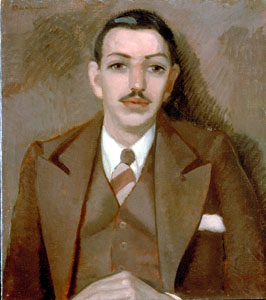"Make way for magic! Make way for objective mysteries! Make way for Love! Make way for the real necessities!"
With these words from his manifesto Refus Global ("total refusal"), painter Paul-Émile Borduas challenged Quebec's post-war conservatism and ignited a debate that extended beyond his immediate art-world audience. Borduas' manifesto was written to accompany an exhibition of artworks by a group of young Montreal artists, Les Automatistes, who were inspired by the surrealists. The manifesto brought the obscure group into the public eye and offended nearly everyone in Quebec with its brash attack on the sacred cows of Quebec society, especially the most sacred of all, the Catholic Church. It also sounded the first murmurings of dissent against the status quo, murmurs that found stronger voice in the sixties' Quiet Revolution.
A thoughtful, intelligent man with a high forehead and a small moustache, Borduas didn't look like a rebel. Born in St. Hilaire in 1905, he was the son of a carpenter and metalworker. Showing an early talent for art, he apprenticed with fellow villager and well-known religious painter Ozias Leduc, from whom he learned the lucrative art of church decoration. With Leduc's help, he secured funding to study in Paris, where he stayed from 1928 to 1930. There he was exposed to the advanced theories that would prompt his mature art and was particularly impressed by the work of Renoir and Cézanne. Returning to Canada, he taught art and eventually found a position at the École du Meuble in Montreal.
Borduas began experimenting with a painting style called "automatism," which drew on the unconscious to create spontaneous abstract compositions. His work inspired a group of young artists who began exhibiting their work around Montreal.
Borduas' decision to publish his manifesto was risky and brave, particularly in a deeply conservative Quebec society. Perhaps his public declaration was inevitable, given the direction that his art had taken. To meet the challenge of the unknown, he had to reject all that could impede the free creation of his art.
Viewed today, the Refus Global manifesto is a curious but powerful document. It describes the history of the Quebec people "kept French and Catholic by resistance to the conqueror," and it attacks, in extravagantly poetic language, the closed-mindedness and fear that insulated Quebec society from change and growth. It referred scathingly to the Catholic Church, political corruption and the self-interest of the moneyed classes that controlled Quebec Society.
With the publication of the Refus Global on August 9, 1948, Borduas and his cohorts ignited a firestorm of debate. Over 200 articles offered opinions for but primarily against Borduas' tirade. His call for personal responsibility and self-reliance and his condemnation of organized political movements set him against both the conservative right and the left. Progressive liberals objected to the manifesto's endorsement of anarchy and nervously condemned its godless tone. For Borduas personally, the manifesto was devastating. He was fired from the École du Meuble and was unable to find another teaching position. Driven by poverty, his wife left their home with their three small children. In 1952 he was forced to sell his house and move in with his brother.
Borduas kept painting, however, and gradually achieved success. He moved to Paris in 1955, where he remained until his death in 1960, though his heart remained in Quebec. By the time he died, his art was internationally acclaimed and his abstract style had become firmly established in Quebec art.
The effect of the Refus Global on Quebec society is harder to gauge. The Refus Global gave voice to dissent and marked the beginning of a process of social change that would transform Quebec society and precipitate the political events that would eventually shake the whole country.

 Share on Facebook
Share on Facebook Share on X
Share on X Share by Email
Share by Email Share on Google Classroom
Share on Google Classroom


